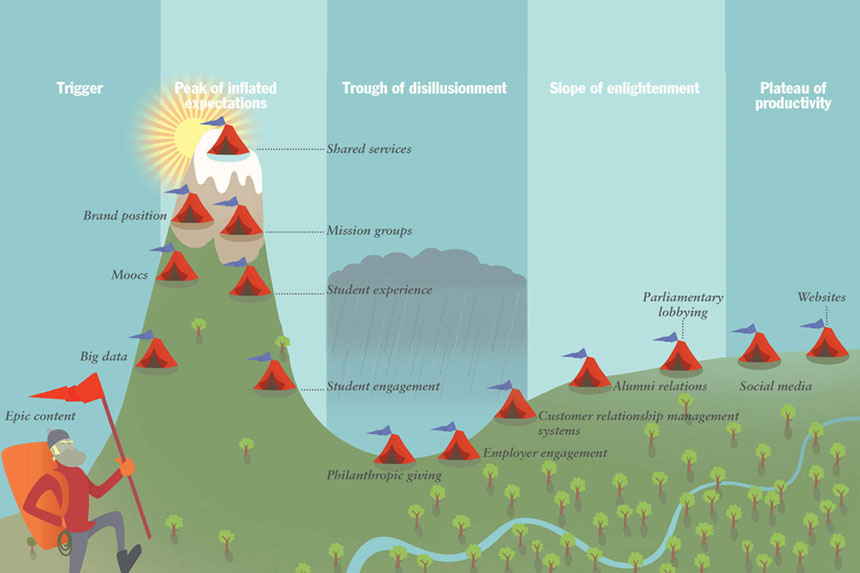Startups: How to survive the Gartner Hype Cycle
If you’re working on a startup in an industry that is getting a lot of hype, the Gartner Hype Cycle adds a lot of pressure to get your product out there
If you work for or with startups, you’ve likely been a part of the Gartner Hype Cycle and the sky-high expectations that can come with it. It goes like this: the potential of a new concept gets over-hyped, and then companies in that area get panned when they don’t meet expectations quickly.

Current examples include the Internet of Things (IoT), which is currently on the mean side of the hype cycle for not evolving fast enough. Bots, the new “it-thing,” seemed to have its golden future locked down when Facebook officially got on the bot bandwagon, only to reach what Gartner calls the “Trough of Disillusionment” in record time. Immediately after Facebook’s announcement, images of broken bots cluttered Twitter. And Microsoft recently had a high profile bot-backfire, when it released a Twitter bot that started tweeting racist content within 24 hours of launch.
But there is hope in hype. Augmented reality has started to exit the Trough of Disillusionment” thanks to the wild success of Pokemon Go and Snapchat filters. According to Gartner (and evidenced by our own bottom line), mobile advertising is now at the “Slope of Enlightenment,” so you could say that we’ve made it through a hype cycle. There have, however, been challenging moments along the way, and many lessons learned. Here are a few tips I can offer to anyone in a hype cycle on how to make it to the other side.

1. Work in stealth until your product — not the concept — is hype-worthy.
If you’re working on a startup in an industry that is getting a lot of hype, the Gartner Hype Cycle adds a lot of pressure to get your product out there. You’ll see glowing report after glowing report in the media about the potential of your space, and you’ll see your competitors get high-profile coverage in trend pieces. It’s very tempting to race to be the first — to be the trailblazing pioneer. Hype is incredibly seductive in that way.
But you have to remember that hype backfires by shortening people’s patience. One minor fail by one company, and the whole industry takes a hit. If you are far away from meeting expectations, the tides can turn in short order. A product that doesn’t fully meet the standards set by that hype can, in a matter of days, tumble from ranking as tech’s golden child to tech’s biggest loser. Like your valuation, hype is only something on paper that can be rewritten overnight. The best defense is to have a concrete, unassailable product by the time you launch.
2. Focus on building a profitable product rather than gaining funding that fuels the hype.
Large rounds of venture funding often go hand-in-hand with hype cycles and sky-high valuations. For years, tech was all about focusing on growth and figuring out profitability later. And while it’s true that figuring out profitability after getting funding can often work (think Google, Facebook, Amazon), raising exorbitant amounts at too high a valuation just feeds the hype cycle.
You don’t always need a large sum of money to grow your business. If you build a good product and are smart and strategic about your marketing, you can grow and even scale it quickly and profitably.
And here I want to be transparent: I’m not saying that new ventures should never take funding. Rather, I’m advocating for truly focusing on your product and thinking about a business model that doesn’t rely long-term on big funding rounds rooted in hype.
3. Don’t let tangential hype cycles influence your strategy.
Just as it can be tempting to rush to get your product out in the midst of hype, it can be tempting to pivot to jump on a hype bandwagon. Think for a moment of Uber and how it set the bar for the so-called On Demand Economy. For a while, it seemed like if your consumer startup wasn’t aiming to be an “Uber for X” solution, you simply weren’t trying hard enough.
But somewhere along the line, investors started to focus less on the “On-Demand” and more on the “Economy” aspect of the vertical. Then the bloodbath came, with startups that offered on-demand services for laundry, housecleaning, parking, prepared meals, car washes, and more folding in quick succession. It’s all a bit reminiscent of the dot-com era, when the rush to serve consumers resulted in any number of ventures with ultimately unsustainable economic models.
This is not to say that you should stick with a strategy that’s not working. But when deciding on your go-to-market strategy — or even which problem you wish to solve — don’t be influenced by hype. Even if it’s easier to raise money in a frothy segment, stay focused and true to your initial vision and the problem you’re solving. Hype is both cheap and fleeting. Your vision is the only thing that will keep you motivated in the tough times.
There’s no doubt that immersing yourself and your business in a hype cycle is fun and even thrilling — it’s always exciting to be an entrepreneur in a new and emerging space. But be careful, and don’t let hype distract you. In the beginning, pay no attention to it and build a product that will do with or without it, and don’t ever change your strategy because of hype.
Thanks to VentureBeat